Studying all those article sure was beneficial.
Great resources. Here's what I learned.
First, base all future changes on your ear. That's the foundation! I'm fortunate in that I am very familiar with this weber grand and its acoustical weaknesses. Which if I didn't play the piano daily, I would not have picked up those nuances. So it was only in a confirmation capacity that the scaling software shows it's value.
Tension is to adjust for core transition smoothness.
Breaking percent is to adjust winding transition smoothness.
Inharmonicity is to refine and compromise between the two.
Impedance is the road map.
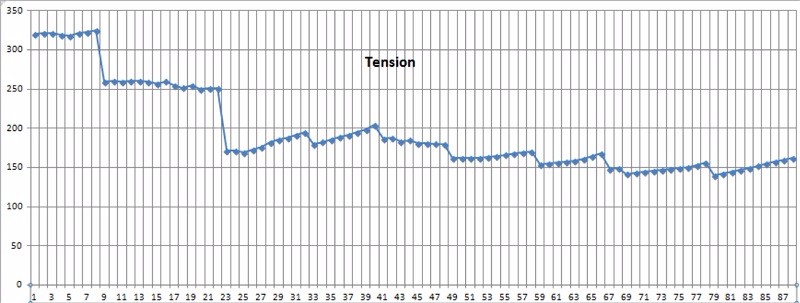

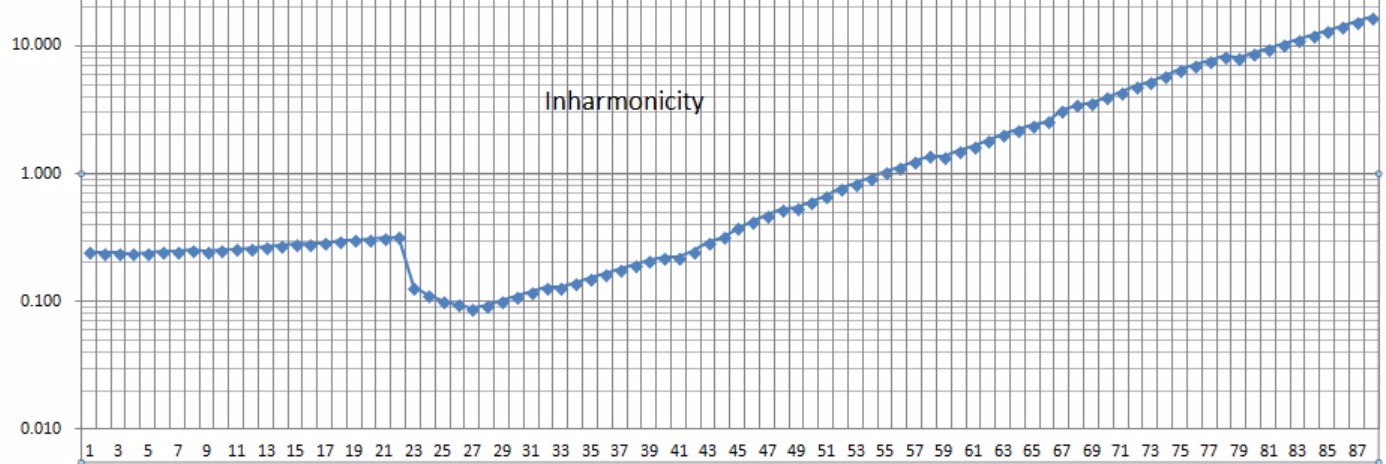

-chris
------------------------------
I have a piano in my Nuclear Fallout Shelter, and my competitors don't. How silly is that?
chernobieffpiano.com
865-986-7720
------------------------------
Original Message:
Sent: 10-24-2017 10:33
From: Chris Chernobieff
Subject: Bedrocks of Acoustics in Journals
A little playing around on the Fairchild reverse formula. I believe instead of 0.5 it should be 0.483, then I was getting the same numbers as he was.
------------------------------
I have a piano in my Nuclear Fallout Shelter, and my competitors don't. How silly is that?
chernobieffpiano.com
865-986-7720
Original Message:
Sent: 10-23-2017 11:22
From: Chris Chernobieff
Subject: Bedrocks of Acoustics in Journals
Any mathematicians out there?
Playing with this reverse tension formula of Steve Fairchild's this morning.
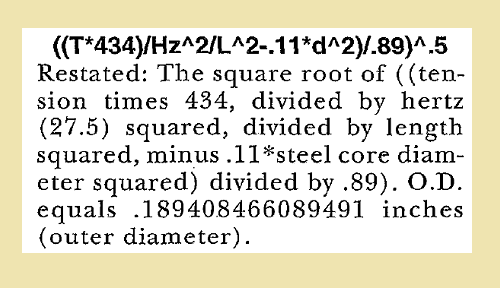
In the article, the example given, core diameter is .061, length is 79.5", and the target Tension is 356Lbs. The formula is suppose to calculate the desired O.D. of .189, but i think there is a typo in the formula.
------------------------------
I have a piano in my Nuclear Fallout Shelter, and my competitors don't. How silly is that?
chernobieffpiano.com
865-986-7720
Original Message:
Sent: 10-22-2017 22:41
From: Chris Chernobieff
Subject: Bedrocks of Acoustics in Journals
Just read Harry Conklins jr's article called "Thoughts on thoughts". January 1999
Sooo good. Insightful!!
Really tore apart the Brown article piece by piece. His longitudinal mode listening and testing was cool. His chart showed an amazing amount of data he used for his decision process of designing string scales was impressive.
He put a lot of emphasis on impedance [ Z=n * (T*M).05 ] and pointed out that this was not even considered by Brown.
His fictional story at the end was hilarious too. Here's a snippet.
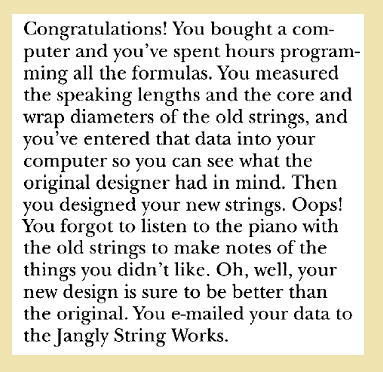
------------------------------
I have a piano in my Nuclear Fallout Shelter, and my competitors don't. How silly is that?
chernobieffpiano.com
865-986-7720
Original Message:
Sent: 10-22-2017 11:57
From: Chris Chernobieff
Subject: Bedrocks of Acoustics in Journals
Looking at the Dave Roberts Tension formula, from the well written journal articles 'The Calculating Technician' of 79-80. Although, they are becoming outdated due to the advancement of computers since they were written. But one point of contention is the mixture of units. Correct me if I am wrong, but, K seems to be based on inches. And A seems to be based on the metric system. Plus there never was any explanation as to how those constants are arrived at - pi, acc/gravity, density, etc. that I could find.
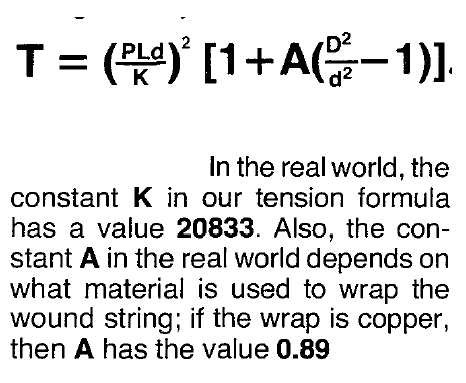
Next i'll be looking at the 1998 Brown articles and the following reaction articles by Fandrich, Sanderson, Tremaine Parsons, and Garrett.
How about those Bedrocks?!
-chris
------------------------------
I have a piano in my Nuclear Fallout Shelter, and my competitors don't. How silly is that?
chernobieffpiano.com
865-986-7720
Original Message:
Sent: 10-21-2017 22:36
From: Chris Chernobieff
Subject: Bedrocks of Acoustics in Journals
Well the Fairchild formulas are not too bad. He admits they're loosely based on Roberts, Sanderson. Maybe someone can share how he differs from them? And perhaps how Fairchild arrives at the 644164 constant?
I'm not a fan of the Note/6 method (which is useful on a calculator i suppose) but I prefer to use and be able to manipulate frequency.
I do like the (1+B) idea tho.
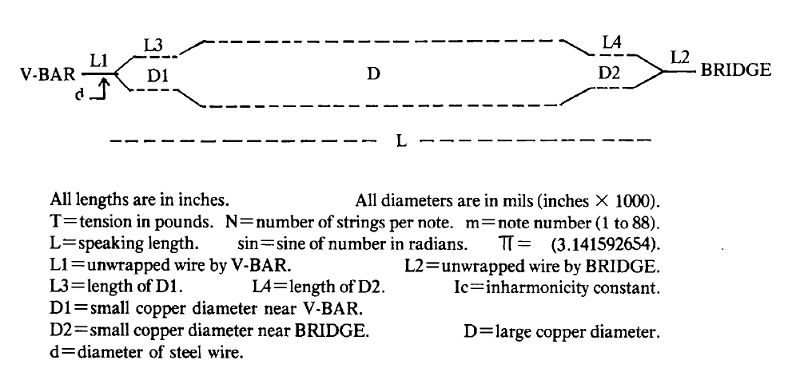
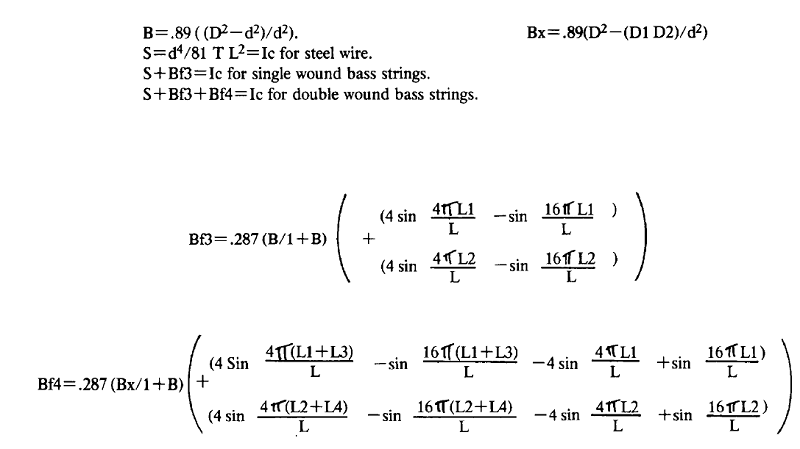

------------------------------
I have a piano in my Nuclear Fallout Shelter, and my competitors don't. How silly is that?
chernobieffpiano.com
865-986-7720
Original Message:
Sent: 10-21-2017 15:40
From: Chris Chernobieff
Subject: Bedrocks of Acoustics in Journals
Well I think i'm done with Fenner. Just too outdated. Looks like his method depends on a special proprietary scale. And there was none with my copy.
So just a little bummed when I came to this paragraph.
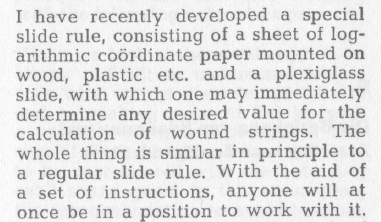
Well it looks like i'll be looking at a S. Fairchild Journal article from 7/1961 next.
------------------------------
I have a piano in my Nuclear Fallout Shelter, and my competitors don't. How silly is that?
chernobieffpiano.com
865-986-7720
Original Message:
Sent: 10-20-2017 10:55
From: Chris Chernobieff
Subject: Bedrocks of Acoustics in Journals
Now Fenner separates into parts the proportion of copper to steel. Then comes up with a new density total (k) to use in the Taylor formula.
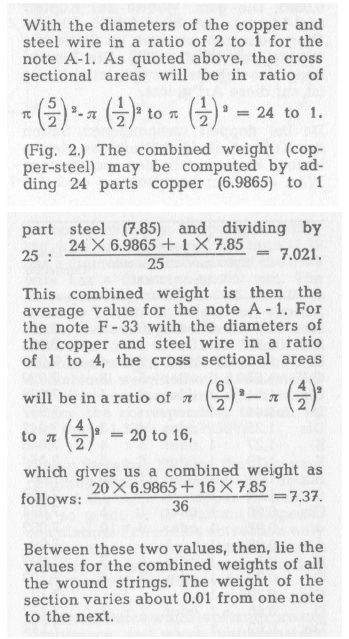
Then averages the values??
Looks like there is a big chart on the next page.
-chris
------------------------------
I have a piano in my Nuclear Fallout Shelter, and my competitors don't. How silly is that?
chernobieffpiano.com
865-986-7720
Original Message:
Sent: 10-19-2017 22:20
From: Mark Schecter
Subject: Bedrocks of Acoustics in Journals
I think you mean miles per hour.
761 x 5,280 = 4,018,080 ft/hour
4,018,080 / 3,600 seconds in an hour = 1,116.133 feet per second.
Etc.
Mark Schecter
| | | | | | | | | | | | | | |_
Original Message------
Yes George, you and google are correct on the calculations.
The formula I was playing with was from A.H Benade's book Sound Production in Pianos. And as Ed (thanks) made me realize, it's the tension formula in disguise. Plus it's missing the diameter!? Looks like the 79.45 number may have been Hz after all.
------------------------------
I have a piano in my Nuclear Fallout Shelter, and my competitors don't. How silly is that?
chernobieffpiano.com
865-986-7720
------------------------------